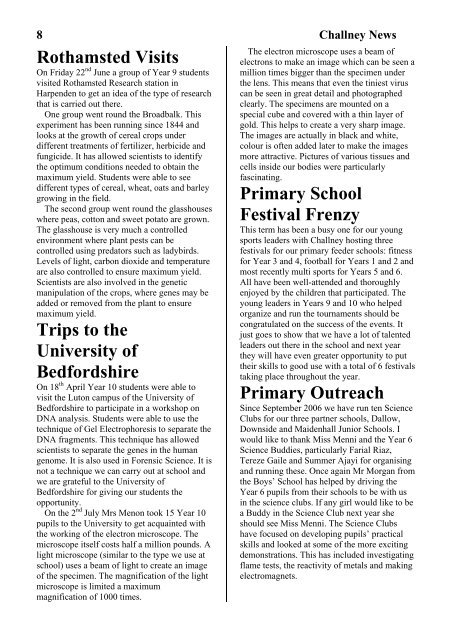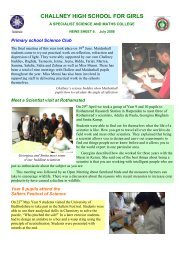The Gazette - Challney High School for Girls
The Gazette - Challney High School for Girls
The Gazette - Challney High School for Girls
Create successful ePaper yourself
Turn your PDF publications into a flip-book with our unique Google optimized e-Paper software.
8 <strong>Challney</strong> News<br />
Rothamsted Visits<br />
On Friday 22 nd June a group of Year 9 students<br />
visited Rothamsted Research station in<br />
Harpenden to get an idea of the type of research<br />
that is carried out there.<br />
One group went round the Broadbalk. This<br />
experiment has been running since 1844 and<br />
looks at the growth of cereal crops under<br />
different treatments of fertilizer, herbicide and<br />
fungicide. It has allowed scientists to identify<br />
the optimum conditions needed to obtain the<br />
maximum yield. Students were able to see<br />
different types of cereal, wheat, oats and barley<br />
growing in the field.<br />
<strong>The</strong> second group went round the glasshouses<br />
where peas, cotton and sweet potato are grown.<br />
<strong>The</strong> glasshouse is very much a controlled<br />
environment where plant pests can be<br />
controlled using predators such as ladybirds.<br />
Levels of light, carbon dioxide and temperature<br />
are also controlled to ensure maximum yield.<br />
Scientists are also involved in the genetic<br />
manipulation of the crops, where genes may be<br />
added or removed from the plant to ensure<br />
maximum yield.<br />
Trips to the<br />
University of<br />
Bed<strong>for</strong>dshire<br />
On 18 th April Year 10 students were able to<br />
visit the Luton campus of the University of<br />
Bed<strong>for</strong>dshire to participate in a workshop on<br />
DNA analysis. Students were able to use the<br />
technique of Gel Electrophoresis to separate the<br />
DNA fragments. This technique has allowed<br />
scientists to separate the genes in the human<br />
genome. It is also used in Forensic Science. It is<br />
not a technique we can carry out at school and<br />
we are grateful to the University of<br />
Bed<strong>for</strong>dshire <strong>for</strong> giving our students the<br />
opportunity.<br />
On the 2 nd July Mrs Menon took 15 Year 10<br />
pupils to the University to get acquainted with<br />
the working of the electron microscope. <strong>The</strong><br />
microscope itself costs half a million pounds. A<br />
light microscope (similar to the type we use at<br />
school) uses a beam of light to create an image<br />
of the specimen. <strong>The</strong> magnification of the light<br />
microscope is limited a maximum<br />
magnification of 1000 times.<br />
<strong>The</strong> electron microscope uses a beam of<br />
electrons to make an image which can be seen a<br />
million times bigger than the specimen under<br />
the lens. This means that even the tiniest virus<br />
can be seen in great detail and photographed<br />
clearly. <strong>The</strong> specimens are mounted on a<br />
special cube and covered with a thin layer of<br />
gold. This helps to create a very sharp image.<br />
<strong>The</strong> images are actually in black and white,<br />
colour is often added later to make the images<br />
more attractive. Pictures of various tissues and<br />
cells inside our bodies were particularly<br />
fascinating.<br />
Primary <strong>School</strong><br />
Festival Frenzy<br />
This term has been a busy one <strong>for</strong> our young<br />
sports leaders with <strong>Challney</strong> hosting three<br />
festivals <strong>for</strong> our primary feeder schools: fitness<br />
<strong>for</strong> Year 3 and 4, football <strong>for</strong> Years 1 and 2 and<br />
most recently multi sports <strong>for</strong> Years 5 and 6.<br />
All have been well-attended and thoroughly<br />
enjoyed by the children that participated. <strong>The</strong><br />
young leaders in Years 9 and 10 who helped<br />
organize and run the tournaments should be<br />
congratulated on the success of the events. It<br />
just goes to show that we have a lot of talented<br />
leaders out there in the school and next year<br />
they will have even greater opportunity to put<br />
their skills to good use with a total of 6 festivals<br />
taking place throughout the year.<br />
Primary Outreach<br />
Since September 2006 we have run ten Science<br />
Clubs <strong>for</strong> our three partner schools, Dallow,<br />
Downside and Maidenhall Junior <strong>School</strong>s. I<br />
would like to thank Miss Menni and the Year 6<br />
Science Buddies, particularly Farial Riaz,<br />
Tereze Gaile and Summer Ajayi <strong>for</strong> organising<br />
and running these. Once again Mr Morgan from<br />
the Boys’ <strong>School</strong> has helped by driving the<br />
Year 6 pupils from their schools to be with us<br />
in the science clubs. If any girl would like to be<br />
a Buddy in the Science Club next year she<br />
should see Miss Menni. <strong>The</strong> Science Clubs<br />
have focused on developing pupils’ practical<br />
skills and looked at some of the more exciting<br />
demonstrations. This has included investigating<br />
flame tests, the reactivity of metals and making<br />
electromagnets.





